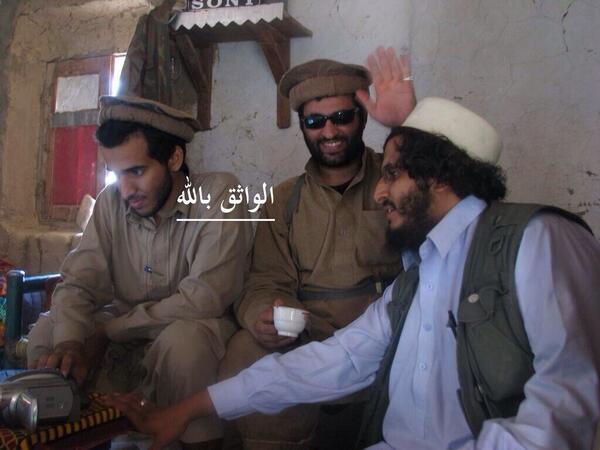|
|
|
Sanafi al Nasr is sitting on the far left in the picture above. The photo was circulated on Twitter following the news of Nasr’s death. |
According to jihadists, a senior al Qaeda leader known as Sanafi al Nasr was killed in the Latakia province of Syria on March 21.
Nasr’s death was first reported by jihadists on social media. Dr. Sami al Uraydi, a sharia official for the Al Nusrah Front, followed up on these reports on his Twitter feed, writing that Nasr had been killed. Al Uraydi asked that Allah accept Nasr in his “caravan” of martyrs.
The Long War Journal first reported on March 6 that Nasr, who is well-known in the online jihadist world, was actually the head of al Qaeda’s “Victory Committee.” The little-known committee is tasked with strategic planning and policy-making for the terrorist organization.
Nasr, whose real name is Abdul Mohsin Abdullah Ibrahim Al Sharikh, was a key ally of the Al Nusrah Front and relocated to Syria from Afghanistan or Pakistan in recent months.
In addition to al Uraydi, other well-connected jihadists have also reported that Nasr was killed. Sheikh Abdallah Muhammad al Muhaysini, a popular Saudi cleric who has 292,000 followers on his Twitter feed, honored Nasr’s “martyrdom” in a series of tweets. Muhaysini and others have retweeted a hashtag that is being used to commemorate Nasr.
Muhaysini and Nasr, who was prolific commentator online, frequently endorsed each other on Twitter.
At odds with ISIS
As first noticed by BBC Monitoring, Nasr reported on his Twitter feed in February that al Qaeda had dispatched a number of veterans to Syria to join the Al Nusrah Front. Two others, Nasr said, were tasked with joining Ahrar al Sham, a powerful extremist organization in Syria that holds key leadership positions within the Islamic Front, which is a coalition of several rebel groups.
Some of the seasoned al Qaeda operatives Nasr referenced (but did not explicitly name) in his tweets took part in the failed effort to reconcile the Al Nusrah Front, al Qaeda’s official branch in Syria, and the Islamic State of Iraq and the Sham (ISIS), which has been disowned by al Qaeda’s general command. Other groups, including Ahrar al Sham, are at odds with ISIS as well.
Muhaysini himself relocated to Syria in late 2013 and proposed a reconciliation initiative, which was accepted by Al Nusrah, Ahrar al Sham, and other groups before being rejected by ISIS.
Nasr was an increasingly vocal critic of ISIS. In the wake of Nasr’s death, some jihadists have circulated his writings online. In one essay in particular, Nasr references the teachings of an al Qaeda ideologue known as Abu Musab al Suri. From the point of view of Nasr and other al Qaeda thinkers, ISIS is repeating the mistakes made by jihadists of the past and is alienating the Syrian population. Al Suri warned against such practices.
Nasr’s “hearts and minds” approach was openly derided by ISIS followers on Twitter. But the Al Nusrah Front and Ahrar al Sham are attempting to implement the guidelines set forth by al Suri, who argued that jihadists should seek to build a popular base of support.
Abu Musab al Suri may or may not still be imprisoned by Bashar al Assad’s regime. There are conflicting reports regarding his status, but much of his written work was compiled a decade or more ago and is still regularly cited.
Abu Khalid al Suri, who was killed in a suicide bombing on Feb. 23, was Abu Musab al Suri’s longtime companion. Abu Khalid was one of the two senior al Qaeda leaders within Ahrar al Sham referenced in Nasr’s tweets. He advocated the same populist approach as Abu Musab al Suri.
Abu Khalid al Suri served as Ayman al Zawahiri’s main representative in Syria and attempted to reconcile ISIS with other jihadist groups, but eventually gave up. Abu Khalid became one of ISIS’ fiercest critics inside Syria before his death, presumably caused by an ISIS suicide bomber.
After Abu Khalid al Suri was killed, Nasr honored him on his Twitter feed, changing the small inset picture at the top of his site to a picture of Abu Khalid. Nasr blamed ISIS for Abu Khalid’s death and called for vengeance.
An al Qaeda family
Nasr came from a family of al Qaeda members and was a third cousin of Osama bin Laden, according to US intelligence officials.
Most of Nasr’s six brothers are known to have joined al Qaeda. Two of Nasr’s brothers were once held at Guantanamo. Leaked files prepared by Joint Task Force Guantanamo (JTF-GTMO) include intelligence reports indicating that the brothers were trained by al Qaeda’s operational commanders to execute an attack against US forces at the Prince Sultan Air Base (PSAB) in Saudi Arabia. They were captured in late 2001 before they could go through with the plot, but al Qaeda attempted a similar attack in 2002.
One of Nasr’s brothers was killed fighting in Chechnya prior to the 9/11 attacks. His “martyrdom” inspired other members of the family to wage jihad, according to the JTF-GTMO files.









2 Comments
I don’t celebrate the death of anyone but, I love reading how these murderers are being removed from society, I just wish it was at a faster pace.
Good. Another one bites the dust, and nobody had to lift a finger, even better.